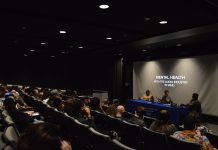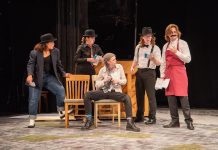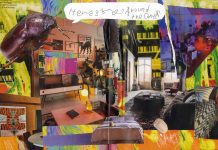 A Japanese woman walking down a tunnel transforms as images of jet planes, mosques and other architecture plays over it. As one image begins to pull out of another, all that remains of the initial shot in Van McElwee’s “Dream Travel” is the Japanese woman.
A Japanese woman walking down a tunnel transforms as images of jet planes, mosques and other architecture plays over it. As one image begins to pull out of another, all that remains of the initial shot in Van McElwee’s “Dream Travel” is the Japanese woman.
McElwee, professor of electronic and photographic media at Webster University, showed off his two newest abstract films “Dream Travel” and “Travel Dream” to an open lecture on Friday, Jan. 18 in the Winifred-Moore Auditorium.
When it comes to taking meaning from his pieces, McElwee said he was purposefully vague because he wanted the viewers to take their own meanings.
“It’s more interesting to get meanings (rather) than (one) meaning,” McElwee said. “I think it’d be boring to decide on a meaning and give it to someone as a riddle. Life is like a mystery. So, why should art be anything less?”

The films are intended to imitate a lucid dream for the viewer with layered images and sounds from McElwee’s worldwide travels. The films were shot during the ‘90s when McElwee traveled throughout Asia. He didn’t begin to use the footage until 2011.
After each film played, the floor went to the audience for questions. Discussion ranged from the religious connotations of McElwee’s films to the technical side of how he edited his pieces.
One scene in which McElwee layered an image of fish over a massive cathedral prompted some viewers to ask about the religious meaning of the scene, because the fish is a symbol of Christianity.
“Not consciously. Unconsciously, probably,” McElwee said.
Aaron Nandor, junior graphic design major, grew an appreciation for McElwee’s art during a class with McElwee.
“I’m a big fan of his video work,” Nandor said. “Through having him as a teacher, I looked up some of his work. I think this one had a bit more of a narrative quality to it. But others of his are a lot more organic and flowing.”

McElwee started as a painter, but his interest in sound led him to multimedia as a means of creating his art.
“I was a painting major,” McElwee said. “In graduate school, I became interested in time-based media and working with sound. Even when I was painting, I was working with sounds.”
McElwee earned his Master of Fine Arts in multimedia from the Washington University School of Fine Arts in St. Louis. He said his first experiments in video were minimalistic.
“(For the) first few years I was working with video, I’d point the camera at the monitor and tilt the camera to create a feedback,” McElwee said. “And you would see one monitor inside another monitor. If you tilt the camera, then you create a series of logarithmic spirals. And if you zoom in and out, you get very creative abstract.”
McElwee has shown his work internationally, and in February, he will travel to Artpool in Budapest, Hungary. Then, he will exhibit his work at ASIFA (Association Internationale du Film d’Animation) in Vienna. Holger Lang, adjunct professor at Webster’s Vienna campus, is organizing the show.



